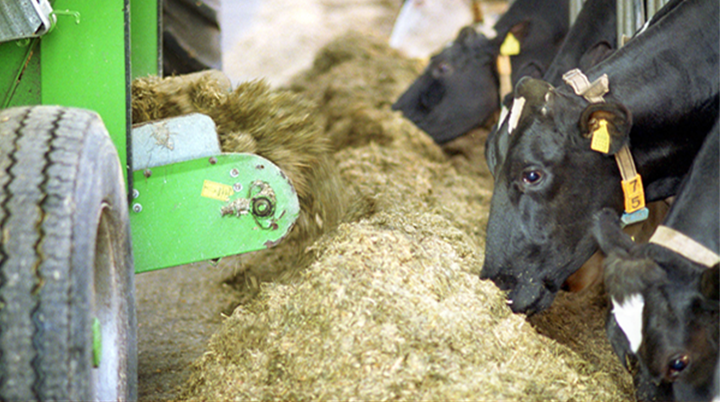Milk urea nitrogen (MUN) as a tool in achieving a balanced diet for dairy cattle
One of the biggest benefits of farming with ruminants is that they have the ability to digest fiber which enables us to feed them a more inexpensive diet compared to monogastric animals. In these tough economic times of today where one is farming with very tight margins, we must make the most of this ability of our dairy cows.

Microbial protein is the main source of protein for ruminants and an adequate ratio between dietary protein and energy is needed to increase the synthesis of this protein, MUN is a good indication of this ratio. As forage enters the rumen, the rumen degradable protein portion thereof is broken down to ammonia which can then be further utilized by rumen microbes to synthesize amino acids and microbial protein while the excess ammonia gets absorb across the rumen wall into the blood. The ammonia is then converted to urea by the liver which is then excreted. There is a direct correlation between blood urea levels and MUN since urea is able to diffuse freely from the blood to the milk. This will then cause an increase in MUN indicating that there is an excess amount of ammonia present in the rumen which is not utilized. Not only does a higher MUN value suggest that there is a wastage of protein but it also means that it needs to be converted to urea which comes at a cost of energy. To fix this problem one can either reduce protein in the diet which will rectify the problem but might come at a cost of lower milk yields. Another solution will be to increase fermentable carbohydrates in the diet which will provide the rumen microbes with sufficient energy to capture the excess ammonia present in the rumen. The optimum levels for MUN are between 10 mg/dl to 14 mg/dl.
During springtime when lush pastures are in abundance, there is a big opportunity for dairy farmers on pastures to reach maximum yield from their dairy cows utilizing the increased levels of protein in their pastures. These seasonal variations in pasture protein is visible in the MUN levels. When pasture protein increases during spring the MUN in milk can increase far above the required ranges, which indicates a low efficiency of utilization of the available protein. In spring the crude protein of especially Ryegrass pastures often exceeds 25%. Although this can be a huge opportunity for higher production, if not managed correctly it might have a negative impact on the animal’s health and also reproduction.
The only drawback of supplementing fermentable carbohydrates as an energy source is that it can only be done up to a certain point. Starch is one of the main nutrients providing energy when fermented. One should be careful to have starch included at levels higher than 25% of the total diet since higher inclusion levels can lead to metabolic disorders such as acidosis. In the case of acidosis, the rumen pH drops and rumen environment become unfavorable for the rumen microbes. At this point, fiber digestion slows down as well as dry matter intake drops. When energy levels are supplemented to the maximum and MUN levels are above ideal it would be best advised to save on feed costs and reduce protein in the diet to lower the MUN levels.
Unfortunately, other factors also play a role in MUN levels. Factors such as improper mixing of feed and sorting will affect the MUN levels since the animal is not receiving the balanced diet that was formulated for her. When sorting takes place or when the diet is not properly balanced the rumen environment might also be altered in such a way that it is not ideal for the rumen microbes. When the activity of rumen microbes slows down due to the rumen environment or external conditions such as temperature MUN levels may vary since rumen microbes are responsible for the amount of free ammonia that leaves the rumen. This may lead to confusion when interpreting the MUN values.
Although many factors are influencing MUN levels it is crucial to optimize your dairy cows’ protein to energy ratio in their diet. By getting the ratio of energy to protein correct in the diet does not only mean the cow is producing milk as efficiently and economically as possible but it also means that one is using the ability of the cow to use the cheapest form of feed to its fullest potential.
For the best nutritional optimization of the dairy ration in order to have have a well balanced ration, please feel welcome to contact De Heus
